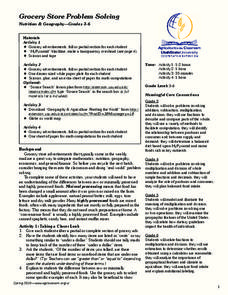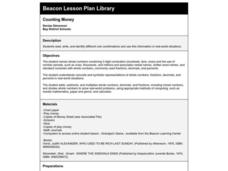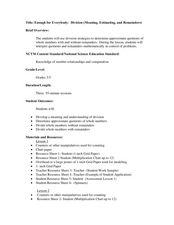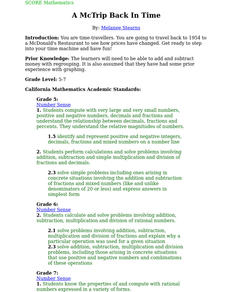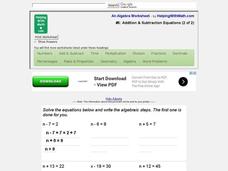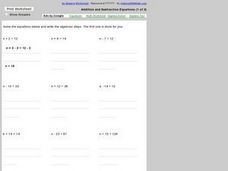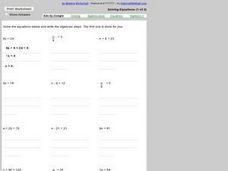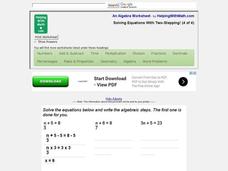Curated OER
Who Wants Pizza?
Students practice fraction skills online at the "Want Some Pizza" website. They complete activities via the internet and on square grid paper. They pull down tabs to check their answers.
Alabama Learning Exchange
Find a Pattern Using Children's Literature
Sixth graders listen to Demi's, On Grain of Rice: A Mathematical Folktale. They use the problem solving strategy of finding a pattern to determine the number of rice Rani will receive after 30 days. They create a spreadsheet which...
Curated OER
Roman Numeral Math
Students solve math problems using Roman numerals. In this roman numerals lesson, students use suggested websites to develop an understanding of Roman numerals and solve simple addition equations. Students create a chart of Roman...
Curated OER
Grocery Store Problem Solving
Students use multiple math skills to complete grocery story problems. In this grocery math lesson, students study grocery ads to learn about the cost of foods. Students investigate food types and the costs of processed versus raw foods....
Curated OER
Counting Money
Students read, write, and identify different coin combinations and use this information in real-world situations.
Curated OER
Using Math with Sale Papers
Fifth graders estimate their results and then prove through calculations. For this math lesson, 5th graders solve problems using multiplication, division, addition, and subtraction. They also use mental math to solve their problems.
Curated OER
Enough for Everybody: Division
Young scholars study division. In this math lesson, students arrange manipulatives into equal groups. Young scholars discuss the relationship between multiplication and division.
Curated OER
Circumference of a Pumpkin
Fourth graders watch a video and find the circumference of a pumpkin. In this circumference lesson, 4th graders watch a video to help them find the circumference of their pumpkins. Students define the word circumference on their data...
Curated OER
A McTrip Back In Time
Students pretend they are time-travellers and travel back to 1954 to a McDonald's Restaurant to see how prices have changed. They need to add and subtract money with regrouping.
Curated OER
Tangram Fractions
Students explore tangram puzzles. In this tangram fraction lesson, students read Grandfather Tang and then practice solving tangram puzzles. Students identify fractions of the pieces of the tangram puzzles and then create a design using...
Curated OER
Models for Dividing Fractions
Sixth graders represent division of fractions using manipulatives, such as freezer pops, candy bars, and models such as drawings squares. They develop an algorithm from these examples and solve problems using fractions.
Curated OER
Does More Wins Mean More Fans At The Ballpark?
Students, after getting information from the past baseball season off the Internet, calculate an attendance-to-win ratio for each of the 28 major league teams and then study the results to see if winning always leads to good attendance.
Curated OER
PAY CREDIT WHEN CREDIT IS DUE
Students learn about credit cards and scores and how to and not to use them. In this financial concept lesson plan, students are given hypothetical scenarios where they are able to apply learning's to given situations as they figure...
Curated OER
Representing Relationships with Equations
Students explore Cuisenaire Rods. For this pre-algebra lesson, students work with a partner to generate addition problems with the sum of ten using Cuisenaire Rods. Students construct examples of the Commutative Property using...
Curated OER
Menu Planner
Students plan a menu for a family of four for a day. They estimate the cost of purchasing items on that menu based on a $ 50.00 budget and calculate the actual costs of those items and compare the estimated and actual costs.
Helping with Math
#6: Addition and Subtraction Equations (2 of 2)
This printable contains 12 basic equations to be solved. The first one is worked out as an example, and the answers for all can be found by clicking on a "Show Answers" box found on the website. The publisher has identified this as...
Helping with Math
#5: Addition & Subtraction Equations (1 of 2)
Single-step addition or subtraction operations are applied in order to solve these 12 simple equations. An answer key is available, not so much for you, but perhaps to be used by learners as a self-correction tool. Note that the...
Helping with Math
#9: Solving Equations (1 of 2)
Twelve very simple equations are presented for learners to solve. What is the value of x? What is the value of n? Individuals apply operations to find the answers. You will find the final answers by clicking on the appropriate box at the...
Helping with Math
Solving Equations with Two-Stepping! (4 of 4)
Here are 12 two-step algebraic equations to be solved. The first problem is completed as an example to your class, but the remaining can be worked right on the page. An answer key is available by clicking on a small box at the top of the...
Helping with Math
Solving Equations with Two-Stepping! (2 of 4)
Multi-step problems are part of the progression when learning to solve equations. These 12 problems require only two steps to arrive at an answer. Either print the page out to assign as homework, or have learners write down the problems...
Helping with Math
#10: Solving Equations (2 of 2)
In this prealgebra activity, pupils perform addition, subtraction, multiplication, or division operations to solve for an unknown. There are 12 problems to be solved. Use this as a quiz to assess how well your class is grasping the skill...
Curated OER
Sorting Nets
Students explore sorting networks. In this computer science lesson, students problem solve as they investigate a parallel processing sorting network.
Curated OER
Fractions and Fact Families: Jump Kangaroo Jump!
Second graders practice with fractions and fact families. In this fractions and fact families lesson plan, 2nd graders participate in a series of activities to assist them with understanding fractions. Activities include graphing,...
Curated OER
Let's Go Consumer Shopping
Second graders rotate through various centers designed to practice consumer math skills. They complete a task card at stations simulating consumer transactions that would take place at toy store, grocery store, restaurant or school store.



